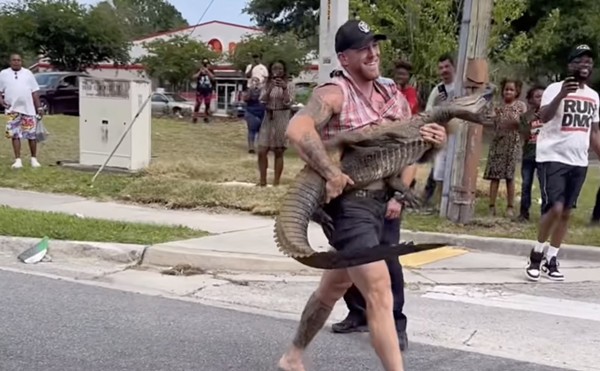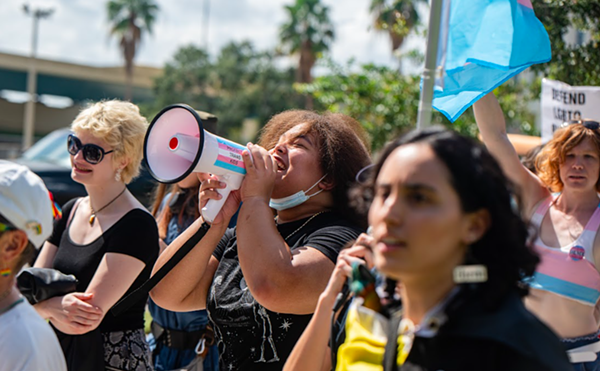Like school districts across the state, Seminole County’s has something of a fiscal crisis. Earlier this month, the school board slashed 343 teaching and support positions. It closed Quest Academy, a school for struggling students. It warned that sports and other extracurricular activities could be next on the chopping block. Put simply, because of state budget cuts, the board needs to trim $22 million from its $474 million annual budget.
You’d think those cuts would be the subject of outrage. And indeed, teachers aren’t happy. “We are very upset about what is going on and are more than disappointed in our legislators along with [Seminole County school] district personnel on how they are making the cuts,” says Gay Parker, president of the Seminole Education Association. But judging by the May 13 school board meeting, another budget cut drew parents’ ire – one you might not expect, given the circumstances.
They wanted to save a mud walk. Or more specifically, they want to save funding for the Environmental Studies Center, a Longwood facility known mostly as a two-day destination field trip for schoolchildren, who traipse along through the nature preserve’s swamp-like mud.
The school board initially indicated that it wanted to cut the center’s $1 million funding altogether, but on May 13 backed down in the face of a massive public outcry. In just over a week, 2,200 parents, teachers and students had signed a petition asking to keep the center’s funding intact. Supporters insist that the mud walk – the center also includes five natural habitats, walking trails and a natural history museum – is an educational experience that children remember forever, and one they shouldn’t be denied.
It might sound asinine to ask the school board to fund the mud walk while it guts more academically crucial programs and personnel – a fact which the center’s supporters acknowledge. But they don’t much care. Dozens packed the May 13 meeting. Students wore green T-shirts decorated with muddy footprints that declared: “Save the Mud Walk.”
The school board acquiesced, somewhat. Instead of cutting all of the facility’s funding, the board instead cut $80,000 out of the center’s annual funding, which will translate to a reduction in the center’s staff and operating hours.
(While the county owns the land that upon which the center rests, the school district owns the building. If the center closed, the building would be handed over to the county.)
That may be a compromise, but to the center’s supporters it’s not enough.
Laura Morgan Winfree, a parent of two Seminole County students, choked up as she read a poem at the school board meeting begging the board to save the mud walk for her young sons.
“There’s a sacred love of land here, a thousand years deep/It’s hiking an ancient mud trail and crossing paths with Mother Nature,” she read, sobbing toward the end of the poem as one of her kids presented the school board with a jar of mud from the center
Per the compromise, for the 2008-2009 school year the facility will be open only 15 hours a week. The staff will be cut in half. The mud walk, which began in 1977, will be a one-day program instead of two.
“This has touched millions of lives,” says Patricia Burkett, who heads the Friends of the Seminole County Environmental Studies Center, a 50-member organization. “You can’t take a few parts and make it whole. You just can’t do it all in one day. One day won’t work.”
Burkett says that in the past, private schools have been offered a one-day mud walk because the center’s calendar was too booked to fit in the full program, but it’s not enough. “Kids didn’t get it,” she says. Burkett argues that this program is part of what makes the Seminole school district “so successful and so unique,” which in and of itself is a justification for keeping it around no matter the school district’s financial situation.
Since the school board won’t fund the mud walk to their liking, Burkett’s Friends have pledged to raise money to pay for the expanded hours. Just to keep the mud walk open a second day, they’d need to raise $24,000 – an enormous task for a small group.
School board members say their decision wasn’t easy. “We’ve protected the project in the past,” says school board member Barry Gainer, who promised to help with the private fund-raising. “This year the cuts are just too deep.”
School board members say they’ve gotten e-mails from all over the world asking them to keep the center open – often from students who had once attended the program. “These are very, very difficult times for all of us,” says school board chair Diane Bauer. “We all have passions we’d like to see fulfilled to the greatest extent possible.”
Resident Julie Parker acknowledges that the outcry may seem hokey to outsiders – but that’s because they don’t have that same slice of old Florida in their backyard. “It’s an old Florida thing. We have swamps and grass and woodlands,” Parker says. “Every state should have something that stands for what it means to that state. We already have it, and the thought that other children might not have it is tragic. I think a lot of people who are not from the area probably look upon it as an expense that we can check off. But it’s a microcosm of everything that is Florida.”
[email protected]
















